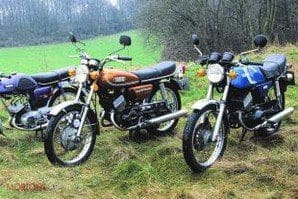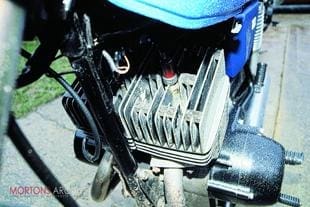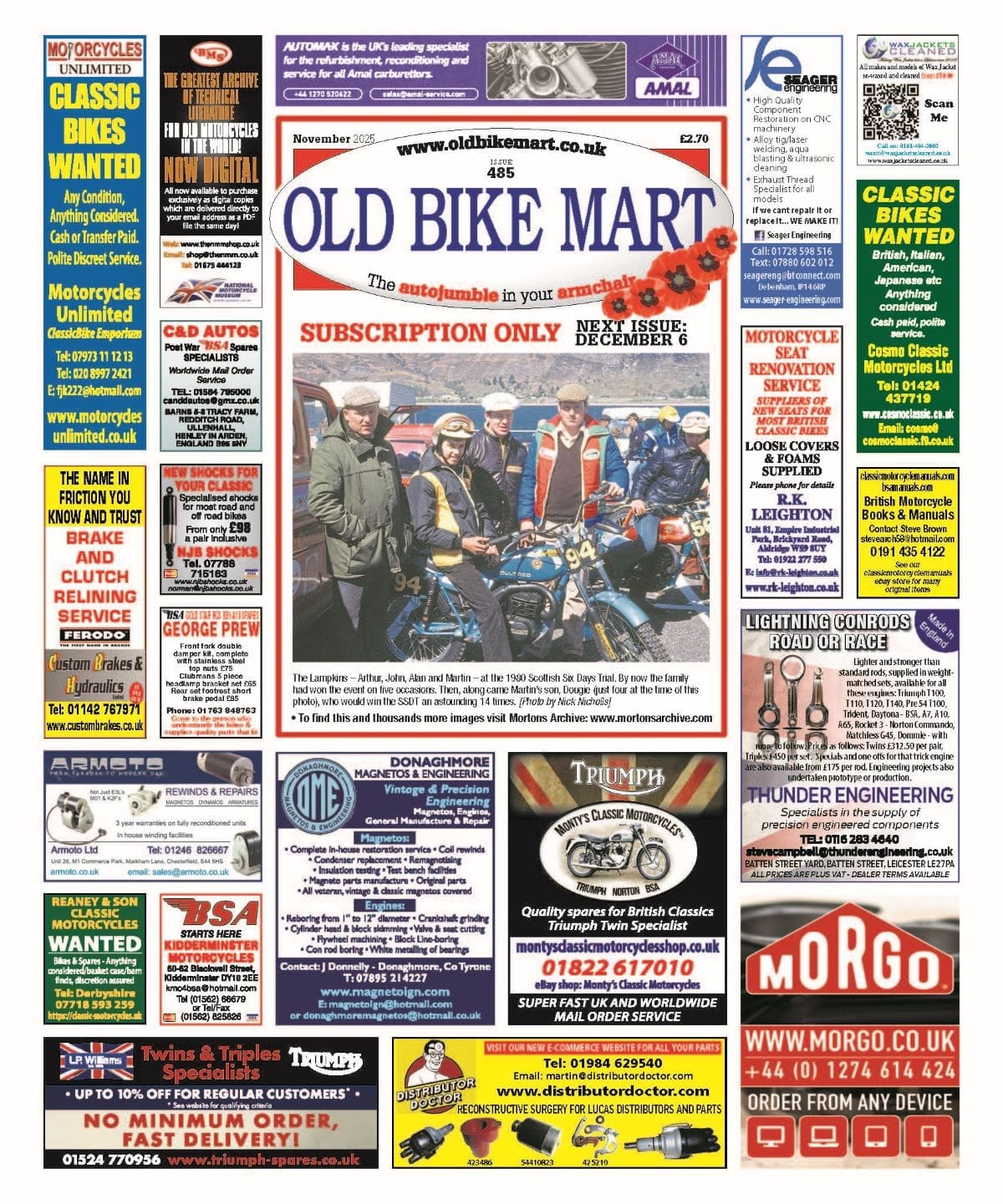
Before the 250cc learner ban, there were all sorts of bikes of around the 175-200cc mark and they were startlingly popular because they only gave a little away to their bigger brothers and were much cheaper to insure.
Yamaha’s RD was probably the one with the longest pedigree. It started life as the CS3 in 1971, and even then it had an electric starter. Like the Suzuki GT185, the starter was in fact the alternator, or in the case of the Yamaha, a 12 volt DC generator.
Hit the button and the polarity was reversed – instead of the engine spinning the generator, the generator spun the engine into life. It grew into the CS5 and then the addition of reed valve induction and seven-port induction plus a few styling changes turned it into the RD200 in 1973.
Enjoy more classic motorcycle reading, Click here to subscribe to one of our leading magazines.
The RD200 boasted well-proportioned curvaceous styling like that of the RD250A, an incredibly neat-looking matt-black engine with polished alloy outer cylinder head fins, and Allen key fastened cases – at a time when everyone else was using those horrible cheese-headed screws. The front brake was a twin leading shoe drum.
This model ran until 1976 when it was dramatically revamped with narrow and squared-off styling, bright orange or blue paintwork and a hydraulic disc. Later on it got a white/red paint scheme and even sprouted cast wheels.
 The wheel change was more for styling reasons than weight saving because they weighed an absolute ton. This was explained if you squinted at one of the spokes, in which was proudly cast the legend ‘Cast Iron’. Yup, Victorian technology was being recycled.
The wheel change was more for styling reasons than weight saving because they weighed an absolute ton. This was explained if you squinted at one of the spokes, in which was proudly cast the legend ‘Cast Iron’. Yup, Victorian technology was being recycled.
The RD was always fast. In 1974 it was speed trapped by Bike at 86 mph, which was staggeringly quick for a 200. Few 250s could top a genuine 90 mph at the time and the RD’s quarter-mile time of 15.6 seconds was equally startling. By way of comparison, the Honda CB200 was seven mph slower on top speed and three seconds slower over the quarter-mile. The RD was also comfortably ahead of the Suzuki GT185.
It wasn’t all top end, either. While it was no torquey single, the RD pulled comfortably from below 4000 rpm: the reed valve induction saw to that. The true power lay over 6000 rpm, as was always the way, but it could be pottered around town quite happily.
Mind you, few people ever did potter them – if it was pottering you wanted, you bought a Honda CB200. The RD200 was aimed straight at the budget-conscious learner and they were ridden flat out everywhere. This meant a fuel penalty; generally you got about 50 mpg, but that was still better than the 40-odd you’d expect from an RD250.
Handling? Yes. Better than the Honda or the Suzuki in that the frame and geometry were more coherent, but the bike was still let down by cheap springy rear shocks and indifferent forks.
As nobody made much aftermarket kit for the 200s (though they certainly did for the 250s) you were generally limited to replacing the rear shocks with Girlings (Konis were way too expensive for the average RD200 buyer) and experimenting with heavier fork oil.
 Something seemed to go visually wrong with the disc-braked model. Yes, you had the extra flash factor of the brake, but the new styling seemed to make the bike much smaller. Normally this is a good thing, but whereas the earlier drum-braked model could be taken, at a glance, to be the 250, you couldn’t make the same mistake with the later bike. The slimmer styling meant a smaller petrol tank too: never a good idea.
Something seemed to go visually wrong with the disc-braked model. Yes, you had the extra flash factor of the brake, but the new styling seemed to make the bike much smaller. Normally this is a good thing, but whereas the earlier drum-braked model could be taken, at a glance, to be the 250, you couldn’t make the same mistake with the later bike. The slimmer styling meant a smaller petrol tank too: never a good idea.
If anything, it looked much more like the rare RD125 twin, so much so in fact, that when the 250cc learner ban came in, quite a few RD200s were simply re-registered by unscrupulous owners as 125s and the side panel decals either replaced or removed altogether.
You had to have a sharp eye to detect the slight difference in the shape of the barrels. The presence of the electric start button was a more obvious give-away – the RD125 never had electric start.
Anyway, somehow it looked too rinky-dink to be a real contender. Even the seat was narrower, which was bad news for a pillion, and higher as well, which was bad news for the short-legged.
However, points were scored for mounting the pillion footpegs on the frame rather than on the swinging arm, which was a sure-fire way of giving your pillion aching knee joints. Another improvement was the fitment of Yamaha’s superb self-cancelling indicators.
At least the new model was still as fast. Bike wound 82 mph out of it in 1978 and allowing for difference in test conditions and the bikes themselves, that meant that every one of the 22 claimed horses was still being properly harnessed. Shame that they were still shocked into life by a Jurassic ignition system that used contact breakers. Even in 1978, electronic ignition was becoming commonplace.
The RD200 died with the 250cc ban. The last few models were flogged off by the discounters and to all intents and purposes road bikes between 125cc and 250cc died in the UK.
 What goes wrong and which to buy
What goes wrong and which to buy
The problem here is that these bikes were generally bought by teenagers and hammered all their lives. All the usual caveats apply. The chrome will probably be rusty and difficult, expensive, or both, to replace. Seat pans will be rotten, trim missing or broken, chassis bearings in swinging arm and headstock worn out.
The engines will probably be rattly and RD200 engine bits are not easy to find. But the real villain is the electric starter. These tend to die early. Often, simply replacing the brushes will resuscitate them, but the ‘dyna-starter’ was never a really good replacement for a separate electric starter motor. At least the RD200 was always fitted with a reliable kickstarter.
The hydraulic disc brake was a single-piston design and has a tendency to corrode and seize over time, unless well cared for.
As the engines were effectively unchanged (barring a bit of paint here and there) during the model run, items like pistons and rings and cranks – the bits that always wear out on two strokes – are common to all RD200s. All the bikes performed just as well, so it really comes down to looks and whether you want a disc brake.
Unless you actually like the angular razor-blade styling of the later models, I’d suggest the drum-braked RD200 is the one to go for. It’s easily the best looking. Also, the early Yamaha twin leading shoe front drum was quite an effective stopper, although it needs regular adjustment.
Even more than other classic bikes, it’s better to buy the best you can rather than try to do up a tatty example on the cheap. Having a crankshaft rebuilt will cost you the same as it will for an RD350LC or Suzuki T500 and new paintwork generally costs the same no matter what bike it’s applied to. Buy one with dead mudguards and a rotten seat, and you could spend ages searching for parts.


